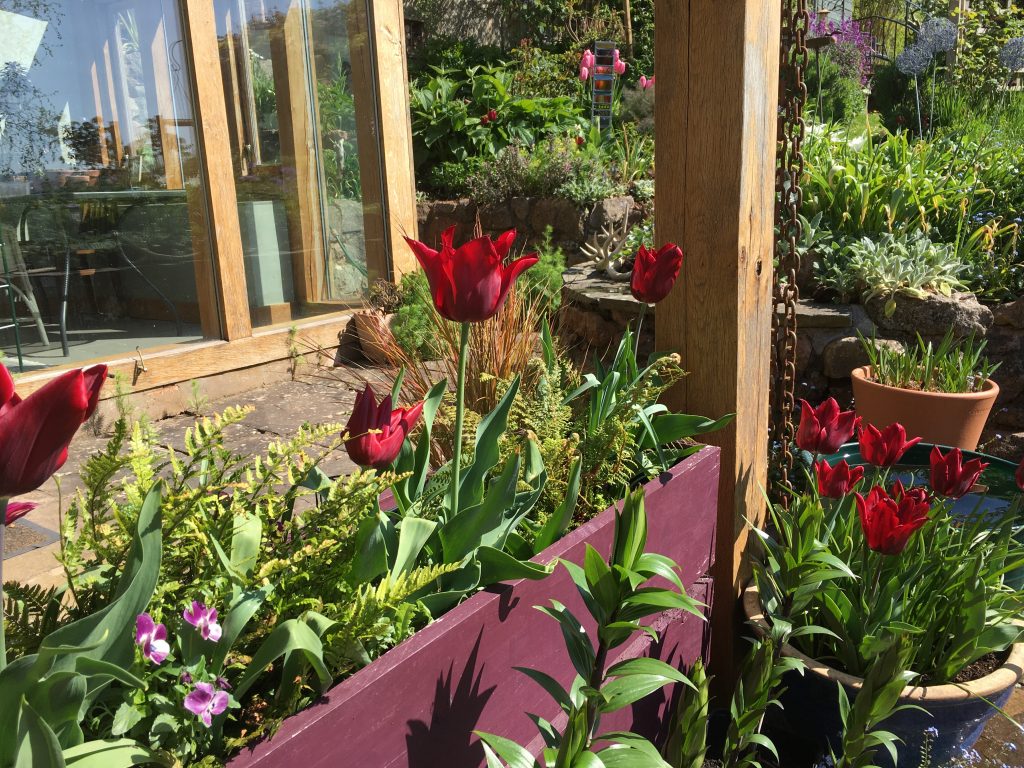Spring delights: Mathlin Cottage, Somerset

Set on the edge of a historic village, Mathlin Cottage in Somerset is a cottage-style garden abundant with the colours of spring.
Behind the cottage seasonal crops grow in the vegetable plot, whilst established beds filled with spring bulbs bring a splash of colour before the views looking out to the Mendip Hills.
Garden Owners, Sally and Tony Harden moved to the garden with their young family over 34 years ago, and it has evolved from the inevitable sandpits and footballs to a sanctuary for local wildlife. Full of bees, butterflies and even the occasional family of hedgehogs, thoughtful planting has ensured the garden is a welcoming place for all creatures great and small.
Take a closer look…
Sally kept her own bees for several years and made the conscious decision to plant plenty of bee friendly plants around the garden. Early in the year snowdrops provide much-needed pollen and nectar for early foraging, whilst; amelanchier, pittosporum, hellebores, perennial cornflower, Centauria, and clematis montana’ Elizabeth have the bees buzzing in spring.
The surrounding wildlife has discovered the garden for itself, with Sally and Tony leaving dark corners unattended, areas of grass left uncut and installing bird boxes. The bug hotels around the garden are already filling up this year, with new solitary bees arriving daily.
Feeding stations are dotted throughout the garden, and two hedgehog houses offer shelter for nesting families. Their presence is evident in drier seasons when crispy grass and borders reveal their crunchy footsteps in the evenings…

How to make your garden more wildlife friendly
- Create a cosy shelter
Creating spots for birds, hedgehogs and insects to shelter is a great way to invite wildlife into the garden. Hedgehog houses, bird boxes and insect hotels are widely available, but with a little bit of creatively, these can easily be made at home too. Creating shelters for the wildlife in the garden is a fantastic way to encourage younger family members to learn more about the life just beyond the garden gate.
- What’s on the menu?
Ensure your garden is well stocked with plants which flower throughout the seasons to provide food for animals that are active over different months. Common garden plants such as ivy, holly and honeysuckle are great winter feeders for the birds, whilst fruit trees and berry bushes are simply irresistible to all garden wildlife year round.
- Rewild your lawns
Replace some of your lawn with flowering plants – re-wild it or plant as a meadow area. This can provide a fantastic habitat for all sorts of insects!
- Introduce bee-friendly plants into your garden
Annuals and perennials such as salvias, sedums, alliums, foxgloves and poppies are just some of the plants that can encourage more bees into the garden. Early blooms for early foraging are also important to remember – hellebores, snowdrops and heather should do the trick! Find out more about bee-friendly gardening here.
If you enjoyed this content please consider making a donation to help us continue to support our nursing and health beneficiaries.
make a donation to support our nurses






















